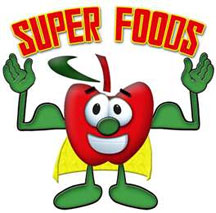Knowing Your Way Around "Super Foods"
By Patty Liston
 There has been quite a bit of discussion during the past year about "super foods". Just what are they? Should we be incorporating them into our diet? Are they only in health-food stores? Let's explore one question at a time.
There has been quite a bit of discussion during the past year about "super foods". Just what are they? Should we be incorporating them into our diet? Are they only in health-food stores? Let's explore one question at a time.
What are "Super Foods"?
The words "super food" is used to define any food that is high in phytonutrients. Phytonutrients are nutrients derived from plant material that have been shown to be necessary for sustaining human life. Most doctors are encouraging their patients to eat more like an herbivore, integrating more plant and fruit based foods into their diets, (think green, colorful, "live" foods), as opposed to their usual carnivore diets of red meats ("dead food"). One such food that is high on the "super foods" list is blueberries. This distinction is due to the significant amounts of antioxidants, vitamin C, manganese and dietary fiber.
 According to Dr. Weil, "super foods" that should be a part of our daily diet are greens, particularly kale, collards, bok choy, and spinach. If you have a desire to increase your intake of fiber, vitamins, calcium and magnesium, greens are the perfect solutions! They are easy on the budget and can be chopped and "hidden" in quiche, scrambled eggs, casseroles, smoothies, you name it. If greens aren't your thing, he suggests we just eat more broccoli. Simple enough!
According to Dr. Weil, "super foods" that should be a part of our daily diet are greens, particularly kale, collards, bok choy, and spinach. If you have a desire to increase your intake of fiber, vitamins, calcium and magnesium, greens are the perfect solutions! They are easy on the budget and can be chopped and "hidden" in quiche, scrambled eggs, casseroles, smoothies, you name it. If greens aren't your thing, he suggests we just eat more broccoli. Simple enough!
Other foods that are recommended are:
- Beans
- Blueberries
- Broccoli
- Oats
- Oranges
- Pumpkin
- Salmon
- Soy
- Spinach
- Tea (green or black)
- Tomatoes
- Turkey
- Walnuts
- Yogurt
 Should we incorporate these foods into our diet?
Should we incorporate these foods into our diet?
Not to overstate the obvious, the answer is YES! Health experts have determined that plant foods can help stem heart disease, cancer, and high cholesterol. These foods are a healthy "drug" that contains no side-effects, and don't involve a doctor's office visit.
"The effect that diet can have on how you feel today and in the future is astounding," says nutritionist Elizabeth Somer, author of Nutrition for a Healthy Pregnancy; Mood, and The Essential Guide to Vitamins and Minerals.
"Even people who are healthy can make a few tweaks and the impact will be amazing," Somer says. "I'd say that 50% to 70% of suffering could be eliminated by what people eat and how they move: heart disease, diabetes, cancer, hypertension can all be impacted."
 Can these foods only be found in health food stores?
Can these foods only be found in health food stores?
No. Everything mentioned in this article can be found at your local market. That said, there are those who suggest that organic foods grown without pesticides or growth hormones are the best for our bodies. Organic foods are no longer relegated to health foods stores, but can now be found in all supermarkets. If you cannot shop organic, be careful to wash all greens and fruits carefully to remove any fertilizers, and/or pesticides.
 Some ways to use the following greens:
Some ways to use the following greens:
Kale. Try it sauteed in a bit of extra virgin olive oil with garlic.
Collards. With a taste similar to that of kale and cabbage, this traditional vegetable from the South makes a wonderful side dish. For the best texture, consider sauteing in olive oil, then covering with water, bringing to a boil and briefly simmering.
Spinach. Spinach ranges in taste from mild to bitter, baby spinach being the least bitter. It can be used raw (be sure to wash raw spinach in cold water before using) as the base of a salad, or steamed or sauteed with a squeeze of fresh lemon juice. Keep in mind that fresh spinach reduces to about half its size when cooked.

